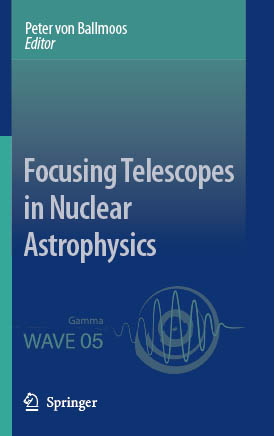 Over the last decade, a small but growing community has been pursuing
various techniques for the focusing of hard X-rays and gamma-rays. The
workshop Focusing Telescopes in Nuclear Astrophysics provided a first
opportunity for this young "gamma-wave" community to meet, exchange
technological know-how, and discuss scientific objectives and
synergies. The workshop took place in Bonifacio, Corsica, September
12-15, 2005. It brought together sixty participants with different
horizons, and with competence in a wide range of different disciplines
- but with a common interest in finding alternative instrumental
approaches for use in nuclear astrophysics.
Over the last decade, a small but growing community has been pursuing
various techniques for the focusing of hard X-rays and gamma-rays. The
workshop Focusing Telescopes in Nuclear Astrophysics provided a first
opportunity for this young "gamma-wave" community to meet, exchange
technological know-how, and discuss scientific objectives and
synergies. The workshop took place in Bonifacio, Corsica, September
12-15, 2005. It brought together sixty participants with different
horizons, and with competence in a wide range of different disciplines
- but with a common interest in finding alternative instrumental
approaches for use in nuclear astrophysics. Participants from the high energy astrophysics community emphasized the extraordinary scientific potential of nuclear astrophysics for the study of the most powerful sources and the most violent events in the Universe. Their contributions are collected in the first part of this volume and discuss science objectives on all levels: neutron stars, X-ray binaries, pulsars, novae, supernovae, AGN, blazars, cosmology … but also our sun! In order to achieve the ambitious scientific goals, experimental gamma-ray astronomy must find new ways to improve the performance of its instruments, with better sensitivity being unquestionably the foremost requirement.
In the second part of this volume, the evolving "gamma-wave" community examines the options for focusing optics for hard-X and soft gamma rays. A few years back, there was no way to focus gamma-rays; today we have many: grazing incident mirrors and multilayer coatings, Laue- and Fresnel-lenses; even an optic using the curvature of space-time is proposed. In more than twenty articles various aspects of the techniques are discussed, from the theoretical basis to the ambitious mission concepts for future space observatories. A particular emphasis is on the progress in R&D for the various techniques, on results from prototypes and on first results obtained from stratospheric balloon flights.
The goal of improving instrument sensitivities by up to two orders of magnitude which is the main incentive for developing focusing telescopes, also drives the development of new detector technologies. One of the focal points of the workshop was the consideration of detectors matching the ambitious objectives of gamma ray optics and their capability of taking maximum advantage of the concentrated signal flux. In the third part of this volume, a number of innovative detector concepts for focusing telescopes are discussed. Besides offering high detecting efficiencies, these focal plane instruments will provide imaging capabilities, perform high resolution spectroscopy and measure the polarization of the incident photons.
The deflection of photons in focusing X/γ-ray optics is only by small angles. As a consequence, telescope systems have long focal lengths and require a new class of flight systems and ground facilities. Part four of this volume is dedicated to the associated challenges. Facilities for testing hard X-ray focusing telescopes on the ground and techniques for testing using stratospheric balloons are presented. The space missions that seem best adapted for X/γ-ray optics involve "formation flying" of two spacecraft. Photons are collected by an optics spacecraft and are focused onto a separate detector spacecraft. Formation flying missions present a number of complex challenges for spacecraft engineering which are discussed in this volume.
Eleven years have past since the workshop on imaging in high energy astronomy in Capri (1994), which itself followed by the same interval a similar meeting in Southampton (1983).
Eleven years is also roughly the time separating launches of successive major space missions in nuclear astrophysics - HEAO-3 (1979), GRO (1991) and then INTEGRAL (2002). One of the foremost objectives of the Gamma Wave 05 workshop was to consider the next generation of instrumentation required for nuclear astrophysics and consider implementation approaches within National and European Space Science programs. In sunny Bonifacio the Gamma-Wave community expressed their wish that the eleven year cycle continue with the launch of a major focusing X/γ-ray mission on a 2013 horizon.
On behalf of the local and scientific organizing committees, we acknowledge the generous contributions of ESA, CNES, ASTRIUM and ALCATEL-ALENIA, which allowed the organisation of the workshop and the publication of the present volume.
We thank Dolores Granat, Eric Deleage and Nicolas Barrière for their tireless effort behind the scenes to ensure the success of this workshop. Many thanks to Gerry Skinner, who has attempted to provide a scientific conscience for the present volume, and to Sylvia Iviglia from Springer for shepherding its completion.
Finally, we thank the participants of the Gamma-Wave 05 workshop for their dedication to this project, and look forward to the exciting promise of the next phase of nuclear astrophysics instrumentation.
Toulouse, July 2006
PvB
Update :29 September 2006
Questions and comments : Peter von Ballmoos



